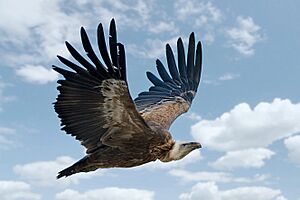Eurasian griffon vulture facts for kids
Quick facts for kids Eurasian griffon vulture |
|
|---|---|
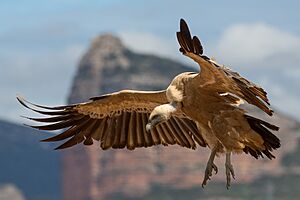 |
|
| A griffon vulture flying in Spain | |
| Conservation status | |
| Scientific classification | |
| Genus: |
Gyps
|
| Species: |
fulvus
|
| Subspecies | |
|
|
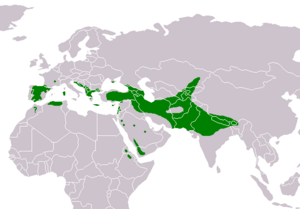 |
|
| Where griffon vultures live | |
| Synonyms | |
|
Vultur fulvus |
|
The Eurasian griffon vulture (Gyps fulvus) is a very large Old World vulture. It belongs to the bird of prey family called Accipitridae. People often just call it the griffon vulture.
This amazing bird is related to the white-backed vulture (Gyps africanus). But don't mix it up with the Rüppell's griffon vulture or the Himalayan griffon vulture!
Contents
Discover the Griffon Vulture's Look
The griffon vulture is a big bird! It is about 93–122 cm (37–48 in) long. Its wings can spread out to a huge 2.3–2.8 m (7.5–9.2 ft)!
Male and female vultures usually weigh between 6.2 to 10.5 kg (14 to 23 lb). Some very large ones can even weigh up to 15 kg (33 lb)!
When they hatch, they are naked. As they grow, they get a white head and a short tail. They have a white ruff of feathers around their neck. Their beak is yellow. Their body and wing feathers are a light brown color. These stand out against their darker flight feathers.
Where Griffon Vultures Live
Griffon vultures live in many places. You can find them in southern Europe, North Africa, and Asia. They like to live in mountains and open areas.
In Italy, these vultures mostly live on the island of Sardinia. But people are trying to bring them back to other parts of Italy. This is called reintroduction. Because of these efforts, more vultures are being seen. Hunting them is also now against the law.
In Croatia, there is a group of griffon vultures near Beli. This town is on the island of Cres. Here, they build nests close to the sea, sometimes only 10 m (33 ft) high. This means they often see people.
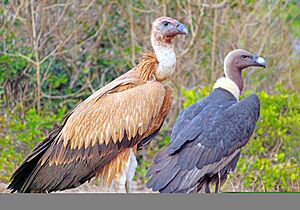
In Ireland, a griffon vulture was first seen in 1843. In 2000, one even lived on the Channel Island of Guernsey for a while.
In Cyprus, there was a small group of fewer than 30 birds in 2006. They lived in Episkopi.

In Israel, you can find griffon vultures in the north and the Golan Heights. There are big groups in the Carmel Mountains and the Negev desert. Special projects are helping them breed in reserves.
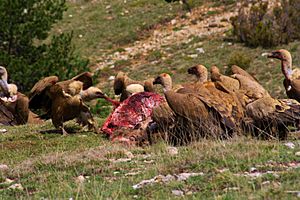
Greece has almost 1000 griffon vultures. Most of them live on the island of Crete. This is the largest group of these birds on any island in the world. They can be seen in groups of up to 20 in the mountains.
In France, griffon vultures have been successfully brought back to the Massif Central. Now, about 500 birds live there. You can often spot them flying over the Millau bridge.
- In Belgium and the Netherlands, about 100 birds were seen in 2007. These birds had flown from the Pyrenees.
- In Germany, the species disappeared in the 1700s. But in 2006, about 200 birds were seen. There are plans to bring them back to the Alps.
In Serbia, there are about 60 to 65 pairs of griffon vultures. They live around Zlatar mountain and the Trešnjica river. These birds are protected by law.
In Austria, some vultures live near Salzburg Zoo. Birds from the Balkans are also often seen there.
Spain and France had 25,000 griffon vultures in 2008. This is a big increase from only a few thousand around 1980. Spain has the largest group of griffon vultures in Europe. They live in the Hoces del Río Duratón Natural Park.
In Portugal, hundreds of pairs of griffons nest. Most of them are in the northeast, in the Douro International. After breeding season, they sometimes fly west.
Sometimes, new rules about leaving dead animals in fields can make it hard for vultures to find food. This can cause problems for them. When food is scarce, griffon vultures might try to find other food. They have been seen going after weak or sick animals.
In Armenia, there are about 46 to 54 pairs of vultures. Their numbers seem to be slowly growing. In Russia, they build nests on the northern slopes of the Greater Caucasus mountains.
Griffon Vulture Behaviour and Life
Like other vultures, griffon vultures are scavengers. This means they eat mostly dead animals. They find food by flying high over open areas. They often fly in groups. When they are resting or eating, they make grunting and hissing sounds.
The longest a griffon vulture has lived is 41.4 years. This was a bird living in a zoo.
They build their nests on cliffs in mountains. They lay only one egg. Griffon vultures often live in groups, called colonies. Most of these birds stay in the same area all year.
How Griffon Vultures Fly and Stay Cool
Griffon vultures are amazing flyers. They use a special way of flying called soaring. This helps them save energy. Big birds like vultures need a lot of energy to flap their wings. Soaring lets them glide on air currents.
When they soar, griffon vultures use much less energy than other birds. They can also get their heart rate back to normal very quickly after flying.
Griffon vultures are also very good at staying cool or warm. They use their bald heads to help with this. By changing their body position, they can show more or less of their bare skin. This helps them cool down when it's hot. They can also handle high body temperatures. This helps them save water and energy. Griffon vultures have one of the widest "comfort zones" for temperature among all birds!
How Griffon Vultures Compete for Food
When griffon vultures eat, their age doesn't seem to change how fast they eat. But they eat faster when there is more food available.
Studies have shown that older adult vultures tend to be more aggressive. They also show more signs of being in charge. Male and female vultures do not act differently when competing for food. Vultures that were raised by humans and those born in the wild also compete in similar ways.
Dangers to Griffon Vultures
The biggest danger to griffon vultures is poisoned bait. Some people put out poisoned food to kill other animals. But vultures eat these poisoned baits by mistake. This causes their numbers to drop quickly.
People who work to protect wildlife are trying to help. They teach others about the dangers of using poisoned baits. This helps keep the griffon vulture safe.
|






